6.1: Identifying Pasta
- Page ID
- 21220
\( \newcommand{\vecs}[1]{\overset { \scriptstyle \rightharpoonup} {\mathbf{#1}} } \)
\( \newcommand{\vecd}[1]{\overset{-\!-\!\rightharpoonup}{\vphantom{a}\smash {#1}}} \)
\( \newcommand{\id}{\mathrm{id}}\) \( \newcommand{\Span}{\mathrm{span}}\)
( \newcommand{\kernel}{\mathrm{null}\,}\) \( \newcommand{\range}{\mathrm{range}\,}\)
\( \newcommand{\RealPart}{\mathrm{Re}}\) \( \newcommand{\ImaginaryPart}{\mathrm{Im}}\)
\( \newcommand{\Argument}{\mathrm{Arg}}\) \( \newcommand{\norm}[1]{\| #1 \|}\)
\( \newcommand{\inner}[2]{\langle #1, #2 \rangle}\)
\( \newcommand{\Span}{\mathrm{span}}\)
\( \newcommand{\id}{\mathrm{id}}\)
\( \newcommand{\Span}{\mathrm{span}}\)
\( \newcommand{\kernel}{\mathrm{null}\,}\)
\( \newcommand{\range}{\mathrm{range}\,}\)
\( \newcommand{\RealPart}{\mathrm{Re}}\)
\( \newcommand{\ImaginaryPart}{\mathrm{Im}}\)
\( \newcommand{\Argument}{\mathrm{Arg}}\)
\( \newcommand{\norm}[1]{\| #1 \|}\)
\( \newcommand{\inner}[2]{\langle #1, #2 \rangle}\)
\( \newcommand{\Span}{\mathrm{span}}\) \( \newcommand{\AA}{\unicode[.8,0]{x212B}}\)
\( \newcommand{\vectorA}[1]{\vec{#1}} % arrow\)
\( \newcommand{\vectorAt}[1]{\vec{\text{#1}}} % arrow\)
\( \newcommand{\vectorB}[1]{\overset { \scriptstyle \rightharpoonup} {\mathbf{#1}} } \)
\( \newcommand{\vectorC}[1]{\textbf{#1}} \)
\( \newcommand{\vectorD}[1]{\overrightarrow{#1}} \)
\( \newcommand{\vectorDt}[1]{\overrightarrow{\text{#1}}} \)
\( \newcommand{\vectE}[1]{\overset{-\!-\!\rightharpoonup}{\vphantom{a}\smash{\mathbf {#1}}}} \)
\( \newcommand{\vecs}[1]{\overset { \scriptstyle \rightharpoonup} {\mathbf{#1}} } \)
\( \newcommand{\vecd}[1]{\overset{-\!-\!\rightharpoonup}{\vphantom{a}\smash {#1}}} \)
\(\newcommand{\avec}{\mathbf a}\) \(\newcommand{\bvec}{\mathbf b}\) \(\newcommand{\cvec}{\mathbf c}\) \(\newcommand{\dvec}{\mathbf d}\) \(\newcommand{\dtil}{\widetilde{\mathbf d}}\) \(\newcommand{\evec}{\mathbf e}\) \(\newcommand{\fvec}{\mathbf f}\) \(\newcommand{\nvec}{\mathbf n}\) \(\newcommand{\pvec}{\mathbf p}\) \(\newcommand{\qvec}{\mathbf q}\) \(\newcommand{\svec}{\mathbf s}\) \(\newcommand{\tvec}{\mathbf t}\) \(\newcommand{\uvec}{\mathbf u}\) \(\newcommand{\vvec}{\mathbf v}\) \(\newcommand{\wvec}{\mathbf w}\) \(\newcommand{\xvec}{\mathbf x}\) \(\newcommand{\yvec}{\mathbf y}\) \(\newcommand{\zvec}{\mathbf z}\) \(\newcommand{\rvec}{\mathbf r}\) \(\newcommand{\mvec}{\mathbf m}\) \(\newcommand{\zerovec}{\mathbf 0}\) \(\newcommand{\onevec}{\mathbf 1}\) \(\newcommand{\real}{\mathbb R}\) \(\newcommand{\twovec}[2]{\left[\begin{array}{r}#1 \\ #2 \end{array}\right]}\) \(\newcommand{\ctwovec}[2]{\left[\begin{array}{c}#1 \\ #2 \end{array}\right]}\) \(\newcommand{\threevec}[3]{\left[\begin{array}{r}#1 \\ #2 \\ #3 \end{array}\right]}\) \(\newcommand{\cthreevec}[3]{\left[\begin{array}{c}#1 \\ #2 \\ #3 \end{array}\right]}\) \(\newcommand{\fourvec}[4]{\left[\begin{array}{r}#1 \\ #2 \\ #3 \\ #4 \end{array}\right]}\) \(\newcommand{\cfourvec}[4]{\left[\begin{array}{c}#1 \\ #2 \\ #3 \\ #4 \end{array}\right]}\) \(\newcommand{\fivevec}[5]{\left[\begin{array}{r}#1 \\ #2 \\ #3 \\ #4 \\ #5 \\ \end{array}\right]}\) \(\newcommand{\cfivevec}[5]{\left[\begin{array}{c}#1 \\ #2 \\ #3 \\ #4 \\ #5 \\ \end{array}\right]}\) \(\newcommand{\mattwo}[4]{\left[\begin{array}{rr}#1 \amp #2 \\ #3 \amp #4 \\ \end{array}\right]}\) \(\newcommand{\laspan}[1]{\text{Span}\{#1\}}\) \(\newcommand{\bcal}{\cal B}\) \(\newcommand{\ccal}{\cal C}\) \(\newcommand{\scal}{\cal S}\) \(\newcommand{\wcal}{\cal W}\) \(\newcommand{\ecal}{\cal E}\) \(\newcommand{\coords}[2]{\left\{#1\right\}_{#2}}\) \(\newcommand{\gray}[1]{\color{gray}{#1}}\) \(\newcommand{\lgray}[1]{\color{lightgray}{#1}}\) \(\newcommand{\rank}{\operatorname{rank}}\) \(\newcommand{\row}{\text{Row}}\) \(\newcommand{\col}{\text{Col}}\) \(\renewcommand{\row}{\text{Row}}\) \(\newcommand{\nul}{\text{Nul}}\) \(\newcommand{\var}{\text{Var}}\) \(\newcommand{\corr}{\text{corr}}\) \(\newcommand{\len}[1]{\left|#1\right|}\) \(\newcommand{\bbar}{\overline{\bvec}}\) \(\newcommand{\bhat}{\widehat{\bvec}}\) \(\newcommand{\bperp}{\bvec^\perp}\) \(\newcommand{\xhat}{\widehat{\xvec}}\) \(\newcommand{\vhat}{\widehat{\vvec}}\) \(\newcommand{\uhat}{\widehat{\uvec}}\) \(\newcommand{\what}{\widehat{\wvec}}\) \(\newcommand{\Sighat}{\widehat{\Sigma}}\) \(\newcommand{\lt}{<}\) \(\newcommand{\gt}{>}\) \(\newcommand{\amp}{&}\) \(\definecolor{fillinmathshade}{gray}{0.9}\)Pasta is made from an unleavened dough of wheat flour mixed with a liquid. The liquid is usually egg and / or water. The flour can be from almost any grain: wheat, buckwheat, rice or a combination of grains. The dough can be colored and flavored with pureed vegetables, herbs or other ingredients, and it can be cut or extruded into a wide variety of shapes and sizes.
Pasta can be cooked fresh while the dough is still moist and pliable, or the dough can be allowed to dry completely before cooking. Pasta can be filled or sauced in an endless variety of ways. It can stand alone, or used in salads, desserts, soups, or casseroles.
Pasta is widely used in the cuisines of Asia, North America and Europe. In Italy, pasta dishes are usually served as a separate course, often referred to as the minestre; in other European countries , Asia and the United States , pasta dishes may be served as an appetizer, entree or side dish.
Identifying Pastas
The better-known pastas are based on the Italian tradition of kneading wheat flour with water and eggs to form a smooth, resilient dough. This dough is then rolled very thin, and cut into various shapes before boiling in water, or dried for longer storage.
Commercially prepared dried pasta products are usually made with semolina flour. Semolina flour, ground from hard durum wheat and available from specialty purveyors, has a rich cream color and produces a very smooth, durable dough. Semolina dough requires a great deal of kneading, however, and bread flour is an acceptable substitute when preparing fresh pasta by hand.
Asian pasta, generally known as noodles, is made from wheat, rice, bean, or buckwheat flour. It is available fresh or dried from commercial purveyors and at specialty markets.
Italian-Style Pasta
Although all Italian-style pasta is made from the same type of dough, the finest commercial pastas are those made with pure semolina flour, which gives the dough a rich, yellow color. Gray or streaked dough probably contains softer flours. Dried pasta should be very hard and break with a clean snap. The surface should be lightly pitted or dull. (A smooth or glossy surface will not hold or absorb sauces as well.)
Dried pasta, both domestic and imported, is available in a wide range of flavors and shapes. In addition to the traditional white ( plain ), green (spinach) and red (tomato) pastas, manufacturers are now offering flavor combinations such as lemon-peppercorn, whole wheat-basil and carrot-ginger. Small pieces of herbs or other flavorings are often visible in these products.
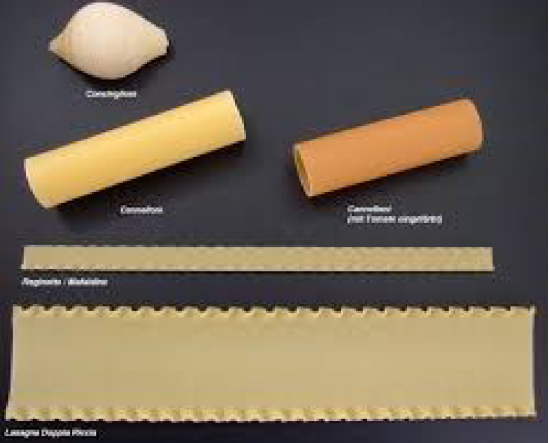
There are hundreds of recognized shapes of pasta, but only two or three dozen are generally available in the United States. When experimenting with unusual flavors and shapes, be sure to consider the taste and appearance of the final dish after the sauce and any garnishes are added.
Italian-style pasta can be divided into three groups based on the shape of the final product: ribbons, tubes and shapes. There is no consistent English nomenclature for these pastas; the Italian names are re cognized and applied virtually worldwide. (A specific shape or size may be given different names in different regions of Italy, however. These distinctions are beyond the scope of this text.)
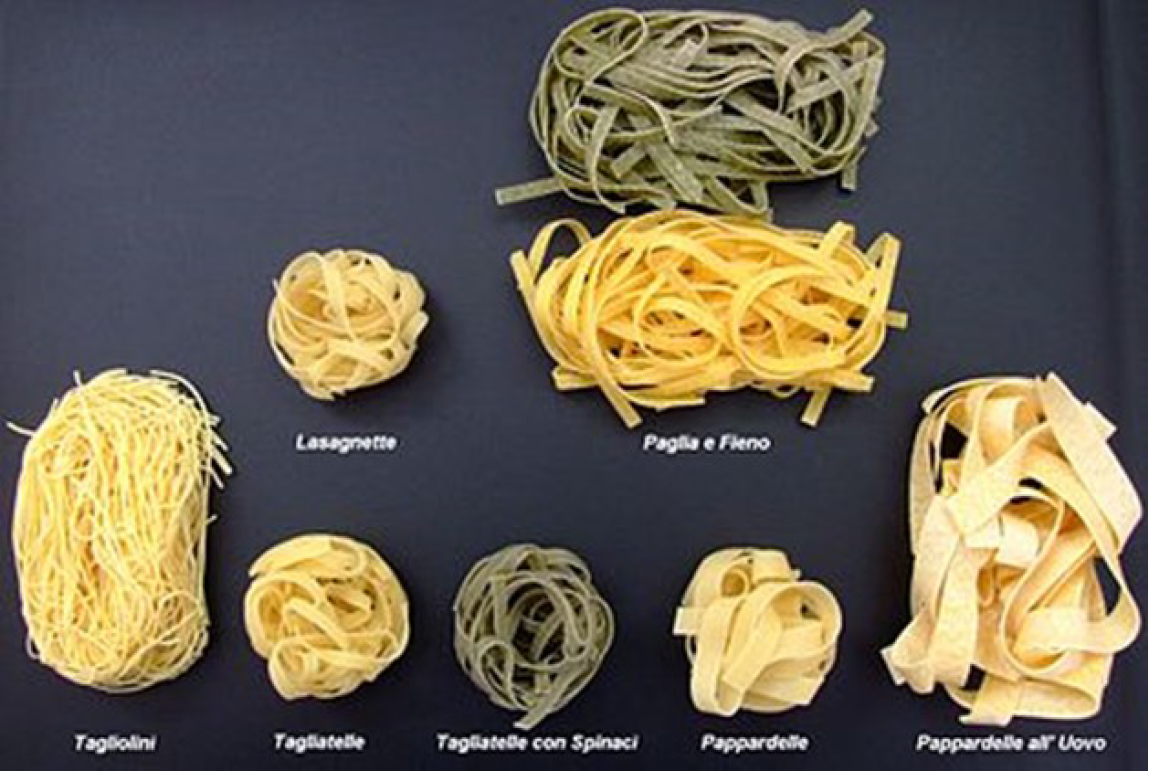
Ribbons
Pasta dough can be rolled very thin and cut into strips, or ribbons, of various widths. All ribbon shapes work well with tomato, fish and shellfish sauces. Thicker ribbons, such as spaghetti and fettuccine, are preferred with cream or cheese sauces. Sheets of fresh pasta dough can be filled and shaped to create ravioli, cappelletti and tortellini. Filled pasta is usually served with a light creamer tomato-based sauce that complements the filling's flavors.
Tubes
Cylindrical forms or tubes are made by extrusion. The hollow tubes can be curved or straight, fluted or smooth. Tubes are preferred for meat and vegetable sauces and are often used in baked casseroles.
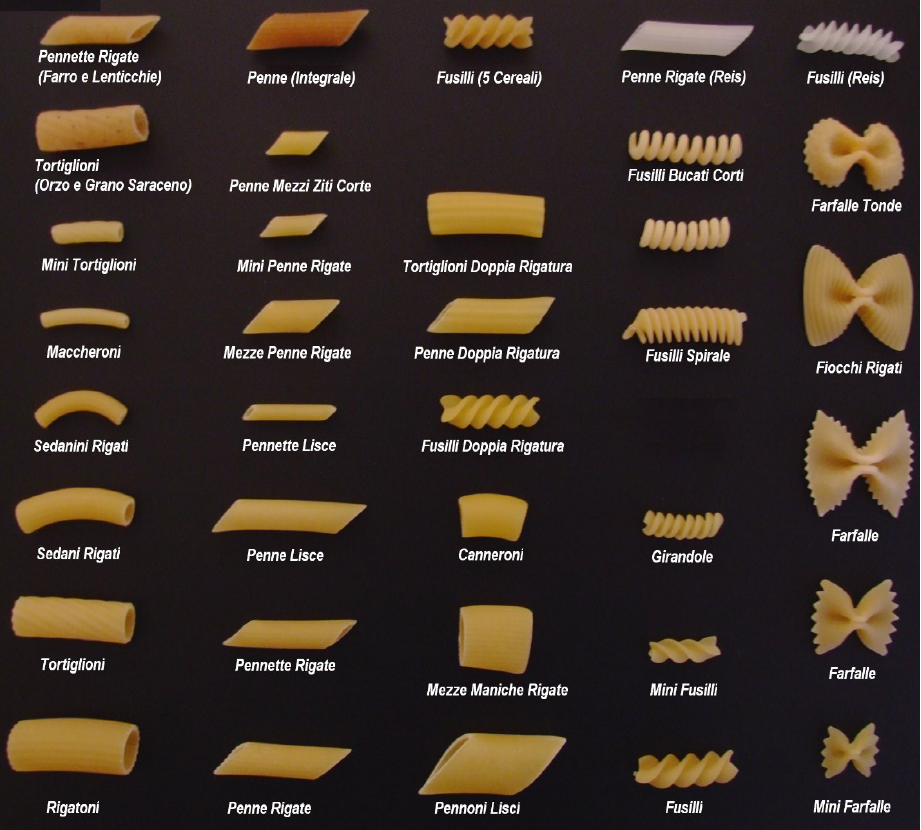
Shapes - Additional Ribbons
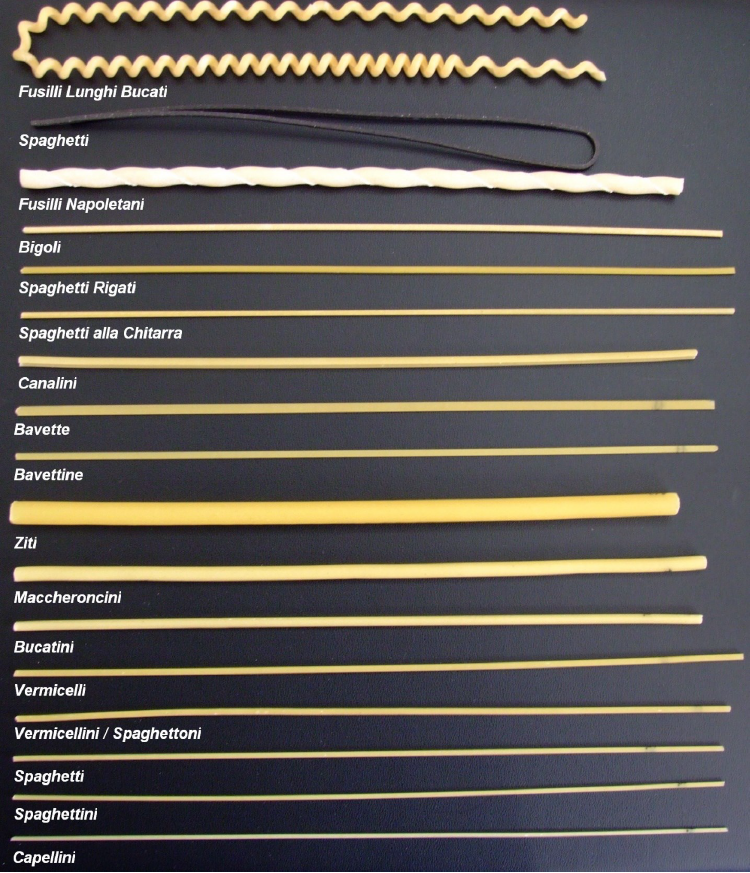
The extrusion process can also be used to shape pasta dough into forms. The curves and textures produced provide nooks and crevices that hold sauces well. Shaped pastas, such as conchiglie, farfalle and fusilli, are preferred with meat sauces and oil-based sauces such as pesto. Larger shaped pastas can be cooked, then stuffed with meat or cheese fillings and baked or served as a casserole.
Gnocchi
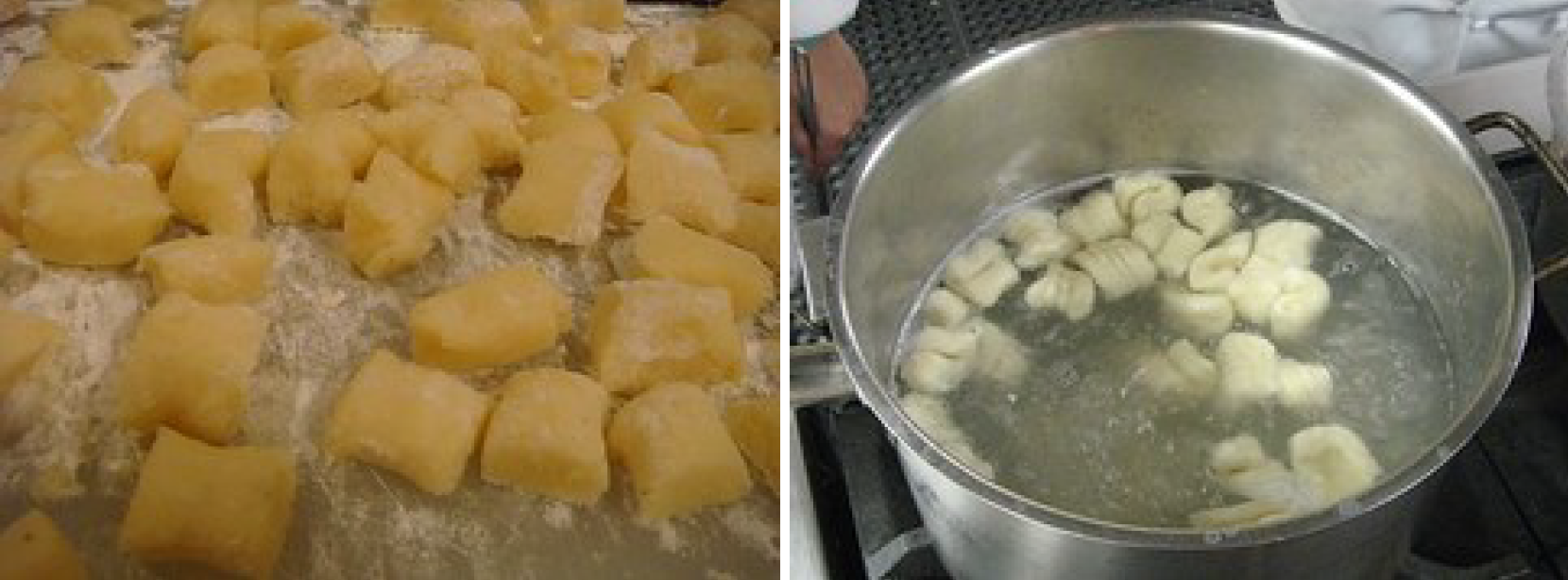
Spaetzle

Cooked Spaetzle Batter passes through device
Asian Noodles
Asian noodles are not cut into the same wealth of shapes and sizes as Italian-style pasta, nor are they flavored or colored with vegetable purees, herbs or other ingredients.
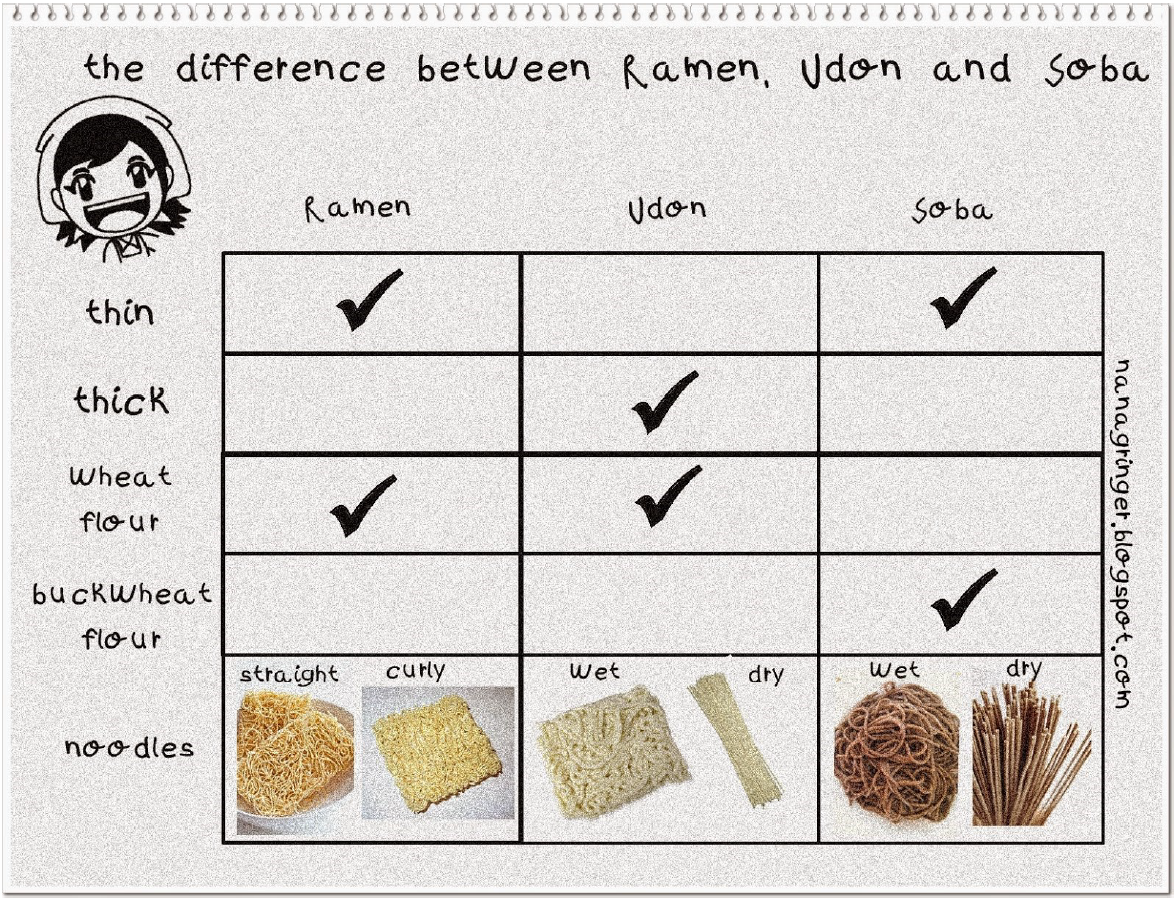
Virtually all Asian noodles are ribbons some thin, some thick-folded into bundles and packaged. Differences arise because of the flours used for the dough. Most dried Asian noodles benefit by soaking in hot water for several minutes before further preparation. The water softens the noodle strands; the bundles separate and the noodles cook more evenly.
Wheat Noodles
Wheat noodles, also known as egg noodles, are the most popular and most widely available of the Asian noodles. They are thin, flat noodles with a springy texture; they are available fresh or dried. Dried egg noodles can be deep-fried after boiling to create crisp golden noodles (chow mein) used primarily as a garnish. Japanese wheat noodles, known as somen (if thin) and udon (if thick), may be round, square or flat. They are eaten in broth or with a dipping sauce.
Rice Noodles
Rice noodles are thin dried noodles made with rice flour. They should be soaked in hot water before coo king and rinsed in cool running water after boiling to remove excess starch and prevent sticking. Rice noodles are often served in soups or sautéed.
Rice vermicelli, which has very fine strands, can be fried in hot oil without presoaking. In only a few seconds, the strands will turn white, puff up and become crunchy. Mounds of crunchy rice noodles can be used as a base for sautéed dishes or for presenting hors d'oeuvre.
Bean Starch Noodles
Bean starch noodles are also known as spring rain noodles, bean threads, bean noodles or cellophane noodles. They are thin, transparent noodles made from mung beans. Dried bean noodles can be fried in the same manner as rice vermicelli. Otherwise, they must be soaked in hot water before using in soups, stir-fries or braised dishes.
Buckwheat Noodles
Buckwheat flour is used in the noodles of northern Japan and the Tokyo region, known as soba noodles. Soba noodles are available fresh or dried and do not need soaking before cooking. They are tradition ally served in broth or with a dipping sauce, but may be substituted for Italian-style pasta if desired.
Dumplings
A dumpling is a small mound of dough cooked by steaming or simmering in a flavorful liquid. Dumplings are found in many cuisines: Italian gnocchi, Jewish matzo balls, German spaetzle, Chinese wontons, Belorussian pelmeni and Polish pierogi Dumplings can be sweet or savory, plain or filled.
Plain or drop dumplings are made with a bread-like dough, often leavened with yeast or chemical leavening agents. They should be light and tender, but firm enough to hold their shape when cooked. Drop dumplings may be served with stews or broths, or coated with butter or sauce as an appetizer or side dish. Filled dumplings are made by wrapping noodle dough around seasoned meat, vegetables, cheese or fruit. These parcels are then steamed, fried or baked and served as a snack food, appetizer or side dish.


